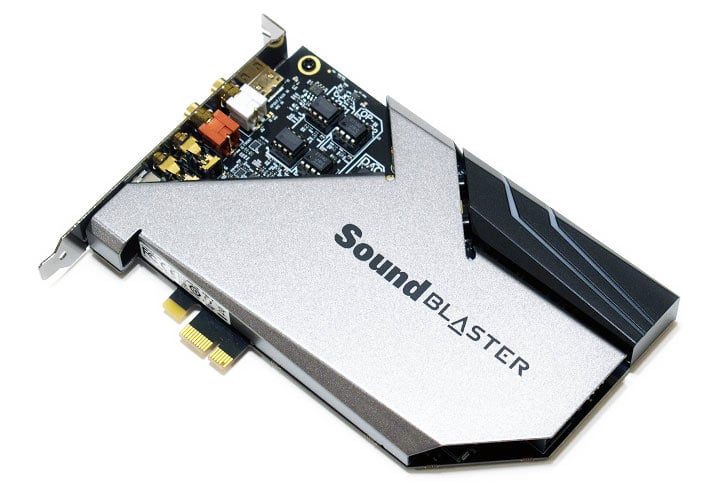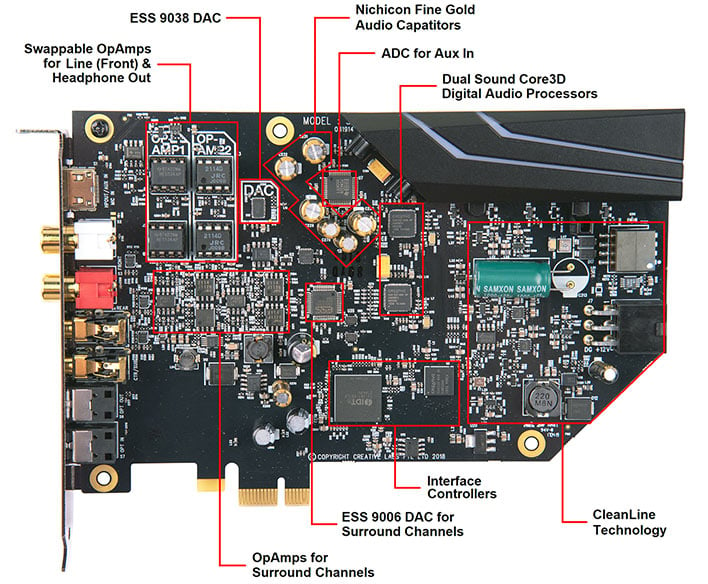Sound Blaster AE-9 Review: Pristine High Def PC Gaming Audio
|
| Interface |
PCI Express x1
|
| Dynamic Range | 129 dB (Stereo, DAC), 123 dB (Stereo, ACM module) |
| Total Harmonic Distortion |
0.0001% (Stereo, DAC), 0.0004% (Stereo, ACM module)
|
| Sampling Rate DSP Playback |
16-bit / 44.1, 48, 88.2, 96 kHz | 24-bit / 44.1, 48, 88.2, 96 kHz | 32-bit / 44.1, 48, 88.2, 96 kHz
|
| Sampling Rate Direct |
16-bit / 48, 96, 192, 384 kHz | 24-bit / 48, 96, 192, 384 kHz | 32-bit / 48, 96, 192, 384 kHz
|
| Sampling Rate Recording | Mic Input: 16-bit / 16, 44.1, 48, 88.2, 96 kHz | 24-bit / 44.1, 48, 88.2, 96 kHz | 32-bit / 44.1, 48, 88.2, 96 kHz Aux and S/PDIF Input: 16-bit / 44.1, 48, 88.2, 96, 192 kHz | 24-bit / 44.1, 48, 88.2, 96, 192 kHz What U Hear Input: 16-bit / 44.1, 48 kHz | 24-bit / 44.1, 48 kHz |
| Headphone Amp |
Supports 16 - 600 ohms impedance
|
| Connectivity |
Main Card:
2 x RCA front L/R channel out, 1 x 1/8" Center / Sub out, 1 x 1/8" Surround L/R out, 1 x Optical S/PDIF out, 1 x Optical S/PDIF in Audio Control Module (ACM): 1 x 1/8" headset out / microphone in, 1 x 1/8" dedicated microphone in, 1 x XLR / TRS microphone, instrument, balanced line input, 2 x RCA line input |
| Power | 1 x PCI Express 6-pin (required for ACM) |
| Pricing |
Creative also blessed the Sound Blaster AE-9 with a bi-amplified pair of Op-Amps to drive high-end headphones. Unlike traditional bi-amplification, which uses multiple amps for different frequency ranges, the AE-9 amplifies the left and right channels separately, which in theory will completely eliminate stereo cross-talk. Because different styles of headphones come with different impedance ratings, the AE-9 also has a three-way toggle that allows owners of sensitive in-ear monitors to reduce impedance while still having the capability to drive high-impedance cans. The card is backed by Nichicon capacitors that live under the AE-9's metal shroud.
With all that output hardware under the hood, it'd be easy to think Creative skimped on the input side, but that doesn't appear to be the case. The card comes with its own breakout box that (along with dedicated headphone outputs and stereo auxiliary inputs) has an XLR / Tip-Ring-Sleeve (TRS) connector for a single microphone or monaural line-level input. The card can capture 16, 24, and 32-bit audio with sampling rates up to 96 kHz. That input also supports optional +48 volt phantom power, which is necessary for condenser microphones. Could this sound card also replace portable, USB-powered audio interfaces for audio production? We'll have to try it out to be sure.
Along with the impressive hardware specs, Creative has bundled a host of software features and effects with with Sound Blaster AE-9. The Sound Blaster Command software has pre-configured equalization profiles for various games and music genres. We're not usually a fans of these effects, but fortunately you can turn them off in the app. Scout mode tries to give gamers a one-up on their opponents by enhancing audio cues like footsteps by means of dynamic range compression at the quiet end of the spectrum without affecting louder sounds. CrystalVoice, Creative's brand name for its vocal-enhancing and input noise-reduction technologies, is also present. As with other recent Creative products, the BlasterX Acoustic Engine DSP is onboard the AE-9. Just like with the AE-5, the maximum playback fidelity comes down from 384 kHz in direct playback mode to 96 kHz with the DSP active.









